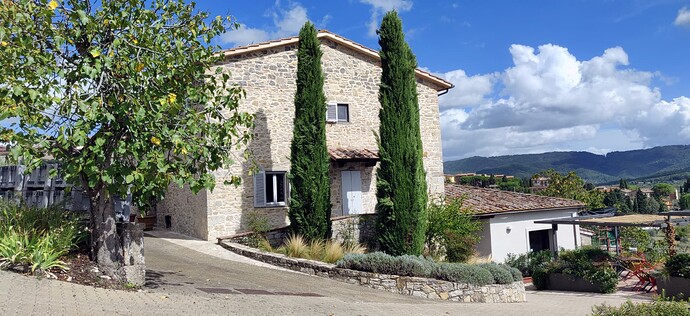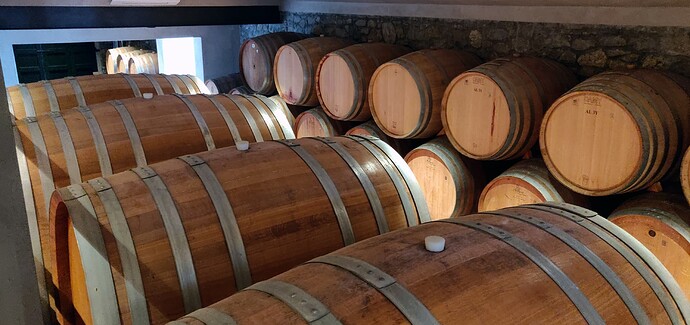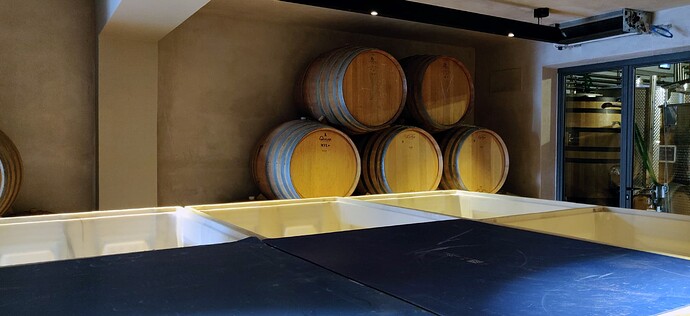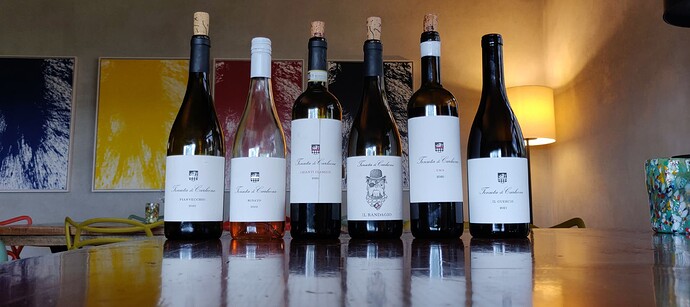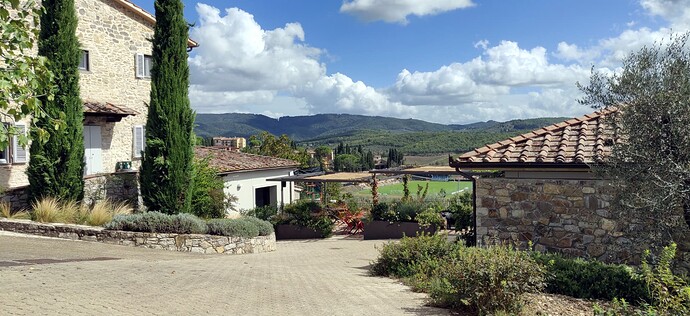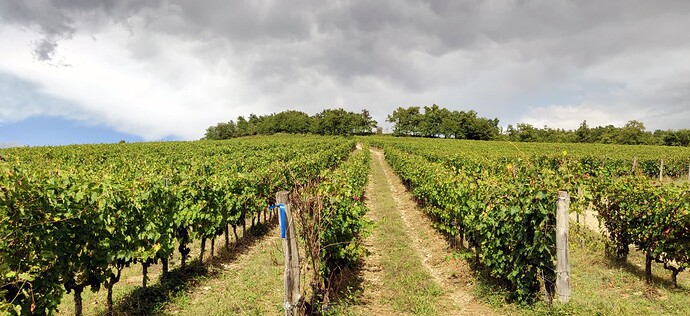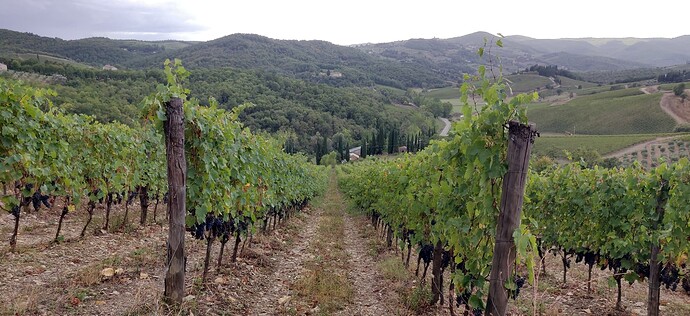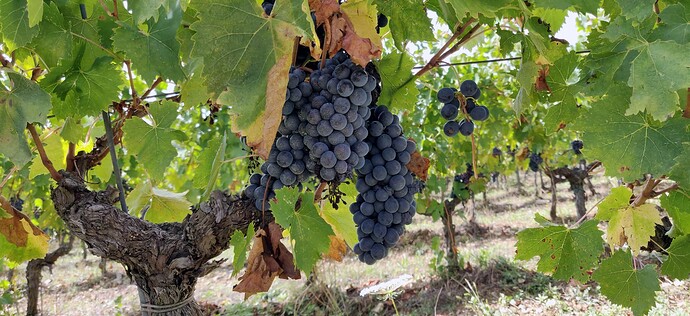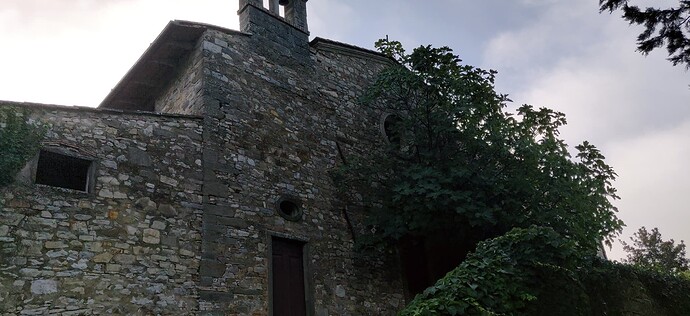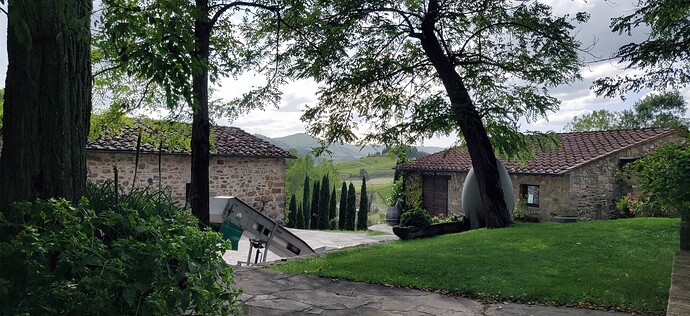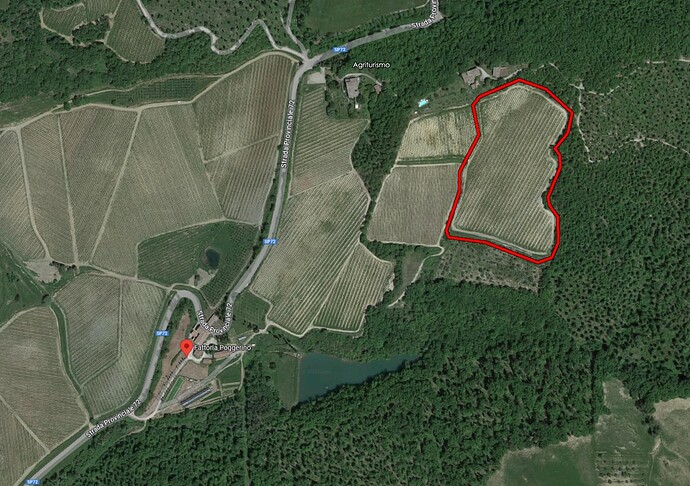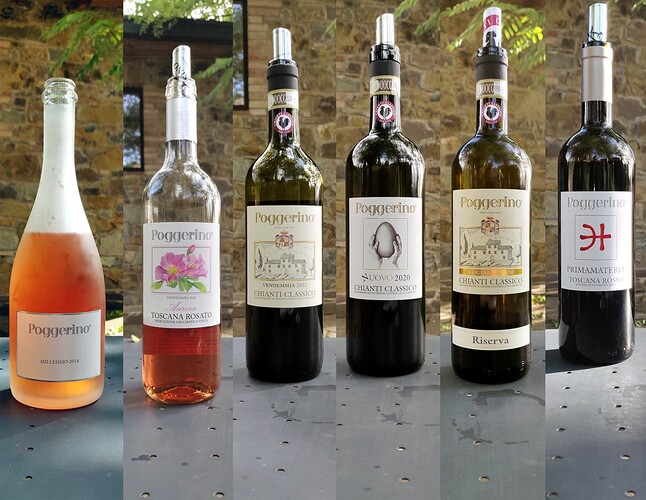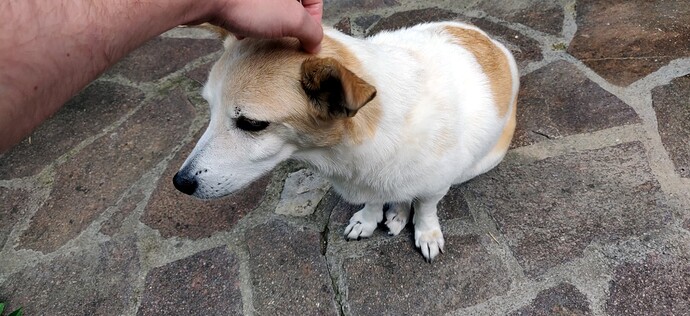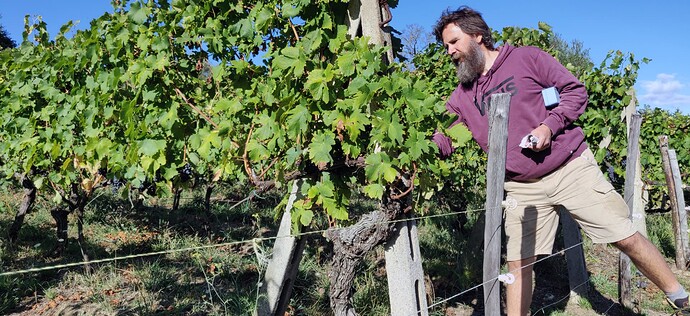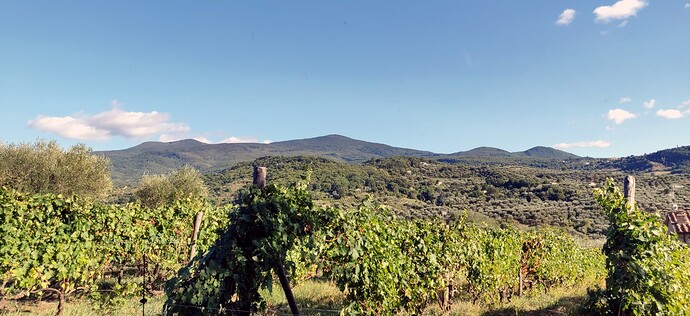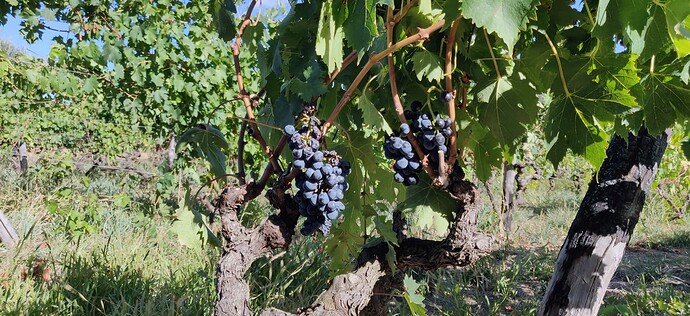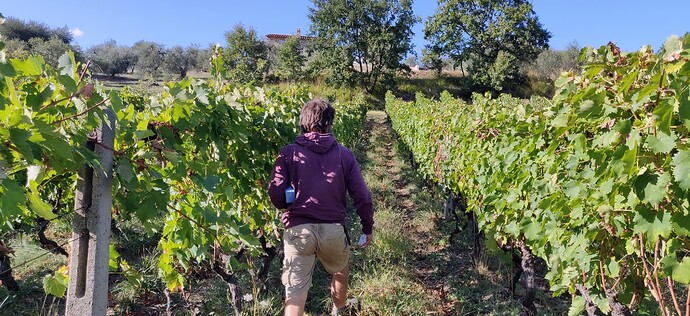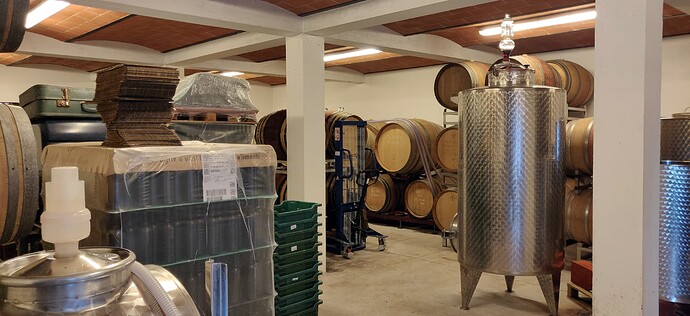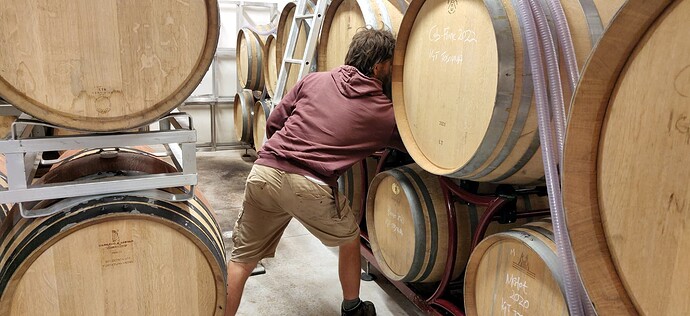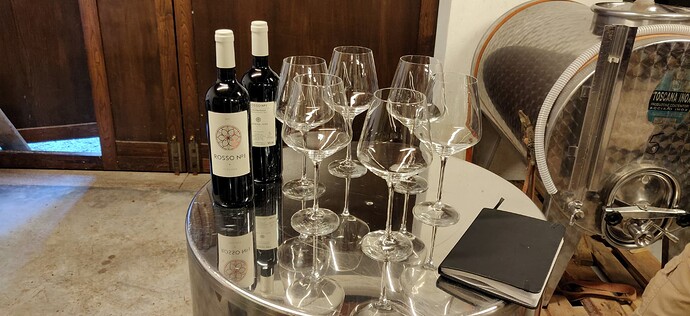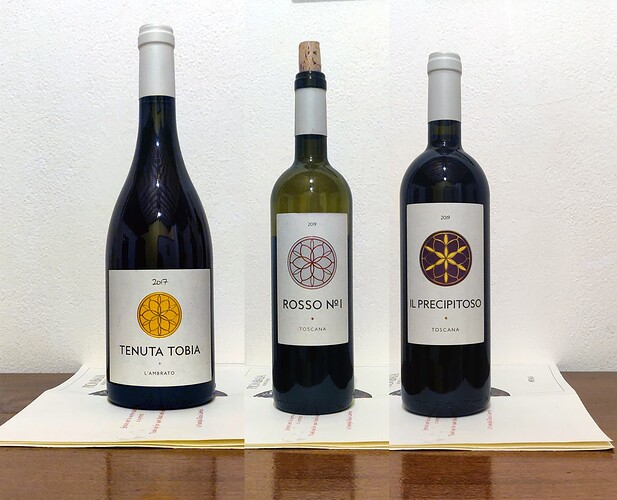Our third winery visit - and second one in Radda in Chianti - was at Tenuta di Carleone. I had originally arranged the visit with the oenologist Sean O’Callaghan, but since he was not available on that day, Alioscia Lombardini - the administrative director of the winery - took did great job showing us around and pouring us the wines.
The wines of Tenuta di Carleone had popped in my radar in a tasting some while ago where their somewhat atypical, light and delicate expression left a positive impression on me. The more I read about the winery, the more often I saw the wines described as “Burgundian” - something which seemed to ring true, based on my observations. Since the winery was located in Radda - a town in which were staying for a few days - we had a perfect opportunity to check out what this winery was all about!
Tenuta di Carleone
This winery is a newcomer in the local wine scene: it has been around only since the early 2010’s! The whole project started when the Austrian entrepreneur Karl Egger of KE KELIT purchased two dilapidated properties right below the northern edge of Radda: the tiny hamlet of Castiglioni and the old Tuscan farmhouse Pianvecchio.
The properties came with approximately 100 hectares of land, encompassing wooded hillsides and around 20 hectares of vineyards. Soon thereafter Egger hired the oenologist Sean “Il Guercio” O’Callaghan - the longtime winemaker at Riecine, in the nearby region of Gaiole - to take care of winemaking while at the same time renovating a medium-sized property right next to the town of Radda to serve as the winery for the project. The renovation of Pianvecchio was finished in 2019 and Castiglioni in 2020 (and today they operate as premium villas one can rent for a minimum period of one week), but when we visited the winery, it seemed like renovations at the winery were still underway, although it has been fully operational for some good while.
Although Egger owns the winery, he has left O’Callaghan to make the wines more or less as he sees fit, so these wines are truly the expression of what O’Callaghan wants to make. The main philosophy of O’Callaghan is that of minimal intervention and minimal extraction, resulting in wines that are wonderfully perfumed and remarkably light and delicate - even in the context of Radda in Chianti, which is already known for their relatively light wines.
O’Callaghan prefers to crush the grapes by foot and ferment the wines spontaneously with indigenous yeasts. Most wines are aged in concrete tanks or even large bins - oak barrels are used quite sparingly and are mostly old and neutral. The portion of new oak in wines that see any oak is kept very small. Furthermore, with some wines O’Callaghan prefers to keep a portion of fruit in whole bunches, thus employing some carbonic maceration in the winemaking. This helps to both add aromatic complexity to the wines and tame down some of the acidity that can be quite high in the wines of Radda.
Concrete tanks to the right, open-top fermentors and stainless steel tanks in the back:
Rows of mainly old tonneaux:
Some more tonneaux along with six plastic tuns (four empty, two filled with wine macerating with the skins):
Thanks to the very delicate winemaking and avoiding extraction, O’Callaghan can keep the wines for remarkably long times in contact with the skins. One to two months of skin contact is perfectly normal for the reds of Tenuta di Carleone, and some wines see up to four months of skin contact - yet the wines remain very delicate with supple and well-controlled tannins.
Unlike many wineries in Radda that have their vineyards in the immediate vicinity of the winery, the (currently 32 hectares of) vineyards are scattered in and around Radda - for example the vineyard from which their flagship red Il Guercio is made is located in the neighboring region of Gaiole. This naturally creates some additional logistical and viticultural challenges, but at the same time is works as a insurance of sorts: a winery with all the vineyards in one place might suffer badly from very localized natural phenomena, like hailstorms, whereas scattered vineyards located in various different places might stay safe for the most part. Furthermore, vineyards located in places with different altitudes and aspects help to even out differences in vintages.
And indeed, the wines are very fine, lithe and delicate! The color in of all the wines can be surprisingly pale and the overall feel in all the wines is very light and ethereal. Even in the flagship reds the tannins are well-managed, making the wines feel texturally very gentle and silky.
When I asked whether people have already found the wines even when the winery is still so young, Alioscia told us that they have no problems with selling the wines: the wines have turned out to be quite sought-after and they selling all their annual production with ease. However, as the winery is still so young, they still struggle to break even due to the costs from founding a new winery, meaning they still operate to some extent with external funding. However, future seems pretty bright at the moment as the new winery renovations are almost finished, they can start to operate without problems at full capacity and the wines continue to sell - although problems vintages like this 2023 (yields down from 30% to 50%!) do cause some unexpected and unwanted delays in the progress.
As for the size of the production, the winery produces approximately 130,000 bottles of wine, of which the basic Chianti Classico covers 60,000 bottles, ie. almost half of all the wine produced.
After going through the winery we tasted all the wines currently in production apart from the “2nd wine”, Due, and the Alicante Bouschet pét-nat, Tinto.
-
2022 Tenuta di Carleone Pianvecchio - Italy, Tuscany, Toscana IGT (23.9.2023)
A blend of white varieties - Vermetino and Riesling, according to the winery; Trebbiano, Malvasia, Vermentino, Riesling and Gewürztraminer, according to the internet - from vineyards averaging 8 years old. The wine is named after the old, traditional farmhouse, "pian vecchio", next to which is a vineyard of white varieties. The grapes are macerated with the skins for a few hours for added aromatical depth. Fermented spontaneously and aged in stainless steel tanks. 12% alcohol.
Pale yellow-green color. The nose feels a bit reticent with somewhat linear aromas of apple and cantaloupe, some floral notes of apple blossom and a little bit of waxy funk. The wine feels refreshing, pretty acid-driven and somewhat neutral on the palate with a quite light body and rather linear flavors of ripe citrus fruits, some fresh white fruits, a little bit of tart Granny Smith apple, light steely mineral notes, a floral hint of white flowers and a touch of borderline unripe pear. The high acidity lends good sense of freshness to the wine. The bone-dry finish is refreshing and rather neutral with a medium-long aftertaste of Granny Smith apple, some lemony tones, a little bit of green herbs and a hint of steely minerality.
Although the wine supposedly sees some international varieties, this still feels like a generic Tuscan white: rather simple and neutral. I guess the Riesling component might be behind the bright, zippy acidity, but I can't say I detected any varietal Riesling flavors at any point. All in all, a decent everyday white, but nothing special to write home about. Not really worth the 18€.
(84 points) -
2022 Tenuta di Carleone Rosato - Italy, Tuscany, Toscana IGT (23.9.2023)
100% Sangiovese harvested early from multiple vineyards around Radda in Chianti. Whole bunch pressed and cold-soaked with the skins for color. Fermented spontaneously and aged for a few months in stainless steel tanks. 12% alcohol.
Pale salmon-pink color. The nose feels very reticent and subtly sweet-toned with vague aromas of strawberries, some nuances of cantaloupe and a whiff of creaminess. The wine feels ripe, juicy and somewhat reticent on the palate with a medium body and quite understated flavors of vague spicy tones, a little bit of creaminess, light strawberry nuances, a hint of stony minerality and a faint touch of salinity. Balanced, moderately high acidity. The finish feels slightly more fruity with a medium-long aftertaste of ripe citrus fruits, some red apple tones, a little bit of saline minerality and a leesy hint of yeast.
A quite pleasant but overall pretty understated, simple and generic little rosé. Drinkable, but nothing that would get me excited in any way. Perhaps a bit pricey for the quality at 15€.
(83 points) -
2020 Tenuta di Carleone Chianti Classico - Italy, Tuscany, Chianti, Chianti Classico DOCG (23.9.2023)
100% organically farmed Sangiovese sourced from multiple vineyards in and around Radda in Chianti. Fermented spontaneously in stainless steel and concrete tanks. Macerated with the skins for two months; 10% of the fruit is kept as whole bunches, undergoing carbonic maceration. Aged for 18 months in stainless steel and concrete tanks. 13,5% alcohol, 0,8 g/l residual sugar, 6,05 g/l acidity, pH 3,42 and 64 mg/l total SO2.
Youthful, luminous and quite translucent black cherry color. The nose feels fragrant, somewhat sweet-toned and slightly perfumed with expressive aromas of dark fruits and ripe black cherries, some brambly raspberry tones, a little bit of sweet floral lift, light aromatic green nuances of raspberry leaf tea, a hint of pipe tobacco and a subtly volatile touch of balsamico. The wine is dry, clean and airy on the palate with a medium body and layered flavors of sour cherries and brambly black raspberries, some earthy tones, a little bit of graphite, light tart notes of lingonberries, a faint hint of farmhouse funk and a touch of fresh dark berries. The overall feel is very balanced and quite sinewy, thanks to the bright high acidity and firm medium-plus tannins that slowly pile up on the gums. The finish is dry, long and gently grippy with a quite intense aftertaste of pronounced sour cherry bitterness, some brambly raspberry, a little bit of tart lingonberry, light earthy nuances, a hint of leathery funk and a touch of gravelly minerality.
A very bright and airy Chianti Classico that is sort of low-key in nature, but not necessarily light or lacking in intensity. This wine just emphasizes the lightness, freshness and elegance that is so typical of Radda Chianti - this wine is not trying to be a big, dark and concentrated blockbuster Sangiovese, but instead is a quite Burgundian take on the style, emphasizing dry, red-toned fruit flavors and brisk acidity. Only the somewhat pronounced sour cherry bitterness that seems to grow in intensity towards end of the aftertaste is what really roots this wine in the realm of Chianti Classico (unlike Carleone's IGT Sangioveses that feel stylistically even more Burgundian than this wine!), along with the good backbone of tannins. The overall style is still very youthful, but I don't expect the wine lose its energy and vibrancy even with extended cellaring. This is a fine and very elegant Chianti Classico that drinks really well right now but will also continue to improve greatly with further aging. Priced according to its quality at 24€.
(91 points) -
2021 Tenuta di Carleone Il Randagio - Italy, Tuscany, Toscana IGT (23.9.2023)
The odd one out in Carleone red wine range: this is a blend of organically farmed Cabernet Franc and Merlot - some sources say it's a 1:1 blend, others say it's a Cab-driven blend. Don't know. The grapes are vinified as whole bunches that are crushed gently by foot, leaving some intact berries for carbonic maceration, then fermented spontaneously and aged on the skins for a long time - 4 months - in concrete tanks. Pressed off the skins and aged in concrete tanks for a total of 12 months. 13,5% alcohol, 0,6 g/l residual sugar, 5,85 g/l acidity, pH 3,51 and 58 mg/l SO2.
Dark, youthful, somewhat translucent black cherry color. The nose feels slightly sweeter and darker-toned compared to the other Carleone reds with aromas of ripe dark berries and some red plums, a little bit of tobacco, light funky nuances of old leather, a hint of dried aromatic leaves of herbs and a touch of fresh redcurrants. The wine feels youthful and quite fruit-forward yet still pretty savory and spicy on the palate with a medium-to-moderately full body and harmonious flavors of ripe red plums and fresh blackcurrants, some lifted floral notes of violets, a little bit of sour cherry bitterness, light spicy notes of crushed peppers and perhaps a little bit of paprika, wild hints of vague leathery funk and balsamic VA and a touch of tobacco. The wine feels fresh and balanced with its high acidity and ripe medium-plus tannins that slowly pile up on the gums. The finish is firm, dark-toned and moderately grippy with a long, dry aftertaste of fresh red plums and blackcurrants, some savory spicy tones, a little bit of tobacco, light sour cherry nuances, a lifted hint of sweet, balsamic VA and a touch of leathery funk.
I'm not usually that keen on Tuscan IGT wines made with international varieties because I'm very partial to Chianti Classico and other Sangiovese wines. However, this wine took me by surprise - even if it is the entry-level wine of the winery made with Bordeaux varieties, it is a surprisingly serious and complex effort for such! Despite the blend of French varieties, the wine isn't made to be a Bordeaux clone - on the contrary, the style is somewhat closer to a Loire Cab, perhaps from a warmer (ie. not herbaceous) vintage. The style here is very delicate and non-extracted, yet not without muscle and fruit. You can taste how the wine really emphasis the purity of fruit, combining judicious sense of ripeness with wonderful sense of freshness and focus. Typical of Carleone wines, there's a little bit of that fragrant, floral character - perhaps from the carbonic component - and a tiny bit of funk that doesn't really overwhelm anything, just adds a lovely overtone of rustic complexity to this otherwise quite delicate and very sophisticated little red. Drinking wonderfully now, but will most likely evolve and improve for at least a handful of years. Terrific value at 16€.
(90 points) -
2020 Tenuta di Carleone Uno - Italy, Tuscany, Toscana IGT (23.9.2023)
One of the two Tenuta di Carleone's flagship Sangioveses. This is 100% Sangiovese made with the best grapes of the best organically and biodynamically farmed parcels in and around Radda. The fruit is crushed by foot and then fermented spontaneously in concrete tanks and open bins, macerated with the skins with minimal extraction over two months. Aged in concrete and stainless steel tanks (90%) and a small portion (10%) in partially new Tonneaux over 18 months. Annual production 15,000 bottles. 13,5% alcohol.
Cleat and very translucent cherry-red color - surprisingly pale for a Sangiovese. The fine-tuned nose feels wonderfully fragrant and attractive with heady aromas of violets and lighter floral nuances of rose petals along with fruity notes of ripe raspberries, fresh Bing cherries and some strawberries, a little bit of cherry marmalade, light sanguine notes of iron, a hint of peppery spice and a touch of sun-baked rocks. The wine feels ripe and sweetly-fruited but also very silky and delicate for a Sangiovese from the heartland of Chianti Classico. The overall feel is airy and medium-bodied with layered flavors of raspberries, some stony mineral notes, a little bit of ferrous blood, light floral nuances of violets and roses, a sweet hint of ripe Bing cherries and a savory touch of meaty umami. Structurally the wine feels balanced and quite supple with its rather high acidity and surprisingly light tannins that slowly pile up on the gums. The lengthy finish is dry, delicate and gently grippy with bright, crunchy flavors of fresh cranberries and brambly raspberries, some sour cherry bitterness, a little bit of meaty umami, light perfumed nuances of sweet floral lift, a hint of wild strawberry and a sweeter touch of ripe dark berries.
This wine is somewhat surprising when tasted after Tenuta di Carleone's Chianti Classico. Normally one would expect the flagship wine to be a bigger, burlier and in all ways more impressive version of the "second wine". Well, in Tenuta di Carleone's case their Chianti Classico (arguably their "second wine") and their flagship wine Uno are just two sides of the same coin: their Chianti Classico is closer to the traditional ideal of the style, sort of more "Bordeaux-like" take on Sangiovese; whereas their Uno is a lighter, more delicate, markedly very Burgundian take on Sangiovese. However, this is still identifiable for a Chianti Classico - albeit a very atypical for the genre. I know people who don't like Chianti Classico because of their noticeably high acidity, often rather grippy tannins and rather pronounced sour cherry flavors - for them this lighter, more delicate take on the style is a perfect alternative. It is lighter, more fragrant and so elegant, yet offering very classic Sangiovese elements at the same time. Although the producer labels it under the IGT Toscana appellation, this is is a Burgundy drinker's Chianti Classico, if anything. It is wonderfully approachable right now, but I expect the wine will continue to evolve and improve for a good amount of years more. Although this is a lovely wine by all accounts, I still feel it is maybe a bit ambitiously priced at 65€.
(91 points) -
2021 Tenuta di Carleone Il Guercio - Italy, Tuscany, Toscana IGT (23.9.2023)
100% single-vineyard Sangiovese from the Mello vineyard located in the hamlet of Lamole, in Gaiole in Chianti, located about 5 km north from the winery and at the altitude of 700 m above sea level. Harvested only when the grapes have reached optimum ripeness, which can be very late in some vintages, due to the exceptionally high altitude of the vineyard. Fermented in concrete tanks (30% whole bunches). Macerated with the skins for 120 days (4 months)! Aged for 12 months in concrete tanks. As the Chianti appellation doesn't allow for vineyards at such high altitudes, the wine is bottled under IGT Toscana appellation - even if it is technically a Chianti Classico in all other aspects. 13,5% alcohol, 0,4 g/l residual sugar, 6,25 g/l acidity, pH 3,55 and 50 mg/l SO2.
Quite noticeably pale and fully translucent raspberry-red color. The perfumed, seductive nose feels very harmonious and attractive with sweetly-fruited aromas of ripe red berries and Bing cherries, some fragrant notes of violets and rose petals, light lifted nuances of ethery VA, a little bit of raspberry juice, a hint of pipe tobacco, a touch of darker forest fruits and a whiff of spice cabinet. Lots of things going on here. The wine feels remarkably delicate, airy and silky smooth on the palate with a rather light body and nuanced flavors of fresh red fruits and sweet strawberries, some crunchy cherry tones, a little bit of stony minerality, light lifted notes of balsamic VA, a savory hint of meaty umami and a touch of brambly raspberry. The structure seems to rely almost solely on the rather high acidity as the light and supple tannins contribute only a little bit to the suave texture, packing no noticeable grip or grit. The finish is savory, slightly warm and subtly grippy with a fresh, layered aftertaste of ripe red fruits, some savory notes of umami, a little bit of brambly raspberry, light perfumed floral tones, a hint of wild strawberry and a faint lifted touch of ethery VA.
Tenuta di Carleone is often described as a winery that makes very Burgundian Chianti Classicos. While I do agree with that sentiment regarding their other Chianti Classicos, this wine doesn't really feel like that description makes it justice. I mean this doesn't really feel like Chianti Classico, this feels more like a Volnay that just happens to come from Tuscany. Although the wine is 100% Sangiovese, the combination of high-altitude vineyards, very delicate (or almost complete lack of) extraction and other winemaking choices have resulted in a wine that is very pure and unadulterated Sangiovese, but at the same time almost unrecognizable for the variety. I don't know if this is good or bad - if you are looking for a Chianti Classico, you might be disappointed with the wine; however, if you are looking for a very harmonious, characterful and elegant red from the lighter end of the spectrum, this is a beautiful wine. Truly a Burgundy-drinker's Sangiovese. I must admit I prefer Carleone's more classically styled, somewhat more structured wines more, but this is still a beautiful wine in its own right. However, the wine feels perhaps a bit pricey for the quality at 50€.
(90 points)
Posted from CellarTracker
The winery (to the left), the tasting room (to the right) and the hills southeast from Radda (in the background):
